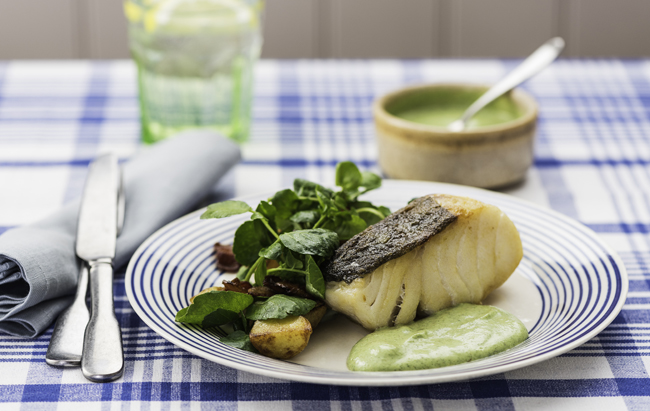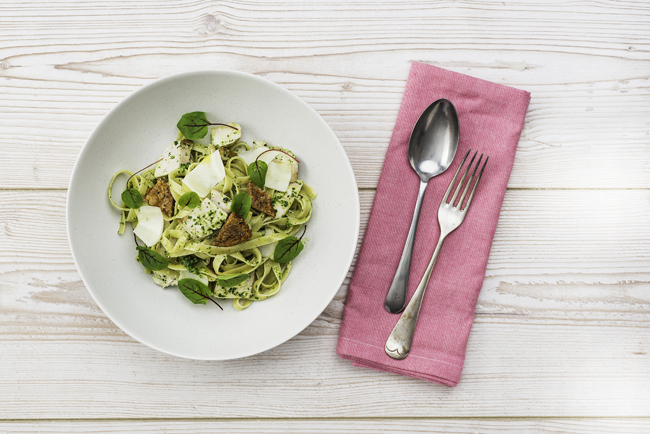Home-grown harvest: Sorrel
The sharp, tart taste of this easy to grow herb, akin to green apples or lemon juice, can add a refreshing contrast in dishes. Russell Brown investigates
Acidity in one form or another must be the most commonly used seasoning after salt in most kitchens. How often does a squeeze of lemon or a splash of vinegar take a dish or a sauce to another level?
Sorrel takes its name from the Old French word for ‘sour'. Its lemon/apple-peel acidity comes from oxalic acid, a slightly controversial substance found in several common food items such as Swiss chard, spinach, rhubarb, cocoa and beetroot. It is even present in tea.
Some nutritionists class oxalic acid as an anti-nutrient, as it binds with other nutrients and prevents them from being absorbed by the body, which may in some cases lead to nutrient deficiencies. It particularly affects calcium, forming insoluble calcium oxalate crystals, which are linked to kidney stones. Overall though, it seems that, for the majority of healthy people, the benefits of food containing oxalic acid outweigh the negatives. Many of the oxalic acid-containing foods are high in vitamins and antioxidants as well as containing significant amounts of dietary fibre.
There are numerous different names for sorrel (garden, common, spinach dock, narrow-leafed dock) as well as different types. In essence, there is the large-leaf type (commonly called garden sorrel) and the much smaller wood sorrel, with its trefoil leaves that fold up into a tent shape at night. Specialist growers Westlands currently lists 11 sorrel products, all of which look distinctly different but have that acidity in common. Some of the sorrels, such as common sorrel and buckler sorrel, come from the genus Rumex, a member of the rhubarb family; while some, such as wood sorrel, come from the genus Oxalis.
From a chef's perspective, the large-leafed sorrel should be used as an ingredient, and the smaller wood sorrel used as a garnish. Garden sorrel is considered easy to grow and can be treated as an annual or perennial; an annual crop will yield softer, smaller leaves which are less acidic. The leaves are usually ready for picking from May onwards.
A sorrel sauce for salmon would be a classic use, but the leaves really can be used in many different ways. The only caveat is that when cooked they turn a sludgy brown colour and reduce in volume in much the same way as spinach. The leaves can be made into soups, added into sauces, risotto or pasta, turned into pesto and dressings and can be infused in cream or stock.
Infused into a syrup, sorrel is used in cocktails such as a sorrel mojito or daiquiri. Indeed, a sorrel and rum baba would be a good dessert option. Chef James Burton of Vallum Cooking in Northumberland juices common sorrel instead of lemon juice, and chooses wood sorrel as a garnish for goats' curd dishes. Chef-proprietor Jon Howe from Lumiere restaurant in Cheltenham makes a sorrel granita as part of a pre-dessert with Amalfi lemon and meringue shards. At the Nut Tree Inn in Murcott, Oxfordshire, chef-patron Mike North uses sorrel as the finishing touch for his home-smoked salmon.
Buying and storage tips • Smaller leaves from the top of common sorrel plants are less acidic
• New leaves from annual crops are softer and more tender
• Leaves can be refrigerated for two to three days
• Micro-sorrels are best kept refrigerated in sealed containers, as the air from fridge fans can damage the delicate leaves.
Market report The best time to look out for sorrel is in spring and summer. It's not as popular as the usual herbs such as basil, chives or rosemary, but if you ask your local supplier or market they should be able to source some for you.
The price is around £13-£14 per kilo and micro-sorrel is usually £2.50 to £3.50 per punnet.
Ashley Clemence, Total Produce www.totalproducelocal.co.uk
Coming soon Over the next few months I will be featuring lettuce and raspberries in Home-grown harvest. Do let me know how you use these products on your menus and what your seasonal favourites are.
Email recipes, dish suggestions and photographs to: russell@creativeaboutcuisine.com
Roast loin of cod, bacon and watercress salad with sorrel and caper yogurt
Serves 4
For the sorrel and caper yogurt 120ml plain, full-fat yogurt
20g sorrel leaves, finely chopped
1tbs small capers, roughly chopped
Pinch of caster sugar
25ml olive oil
Maldon sea salt and freshly ground black pepper
Ultratex to thicken, if required
For the bacon and watercress salad 1tbs olive oil
4 rashers smoked streaky bacon, cut into 2cm pieces
1tbs balsamic vinegar
150g sautéed new potatoes, warm
60g watercress, large stalks removed
For the cod 4 x 150g thick, boneless cod fillet portions
30ml olive oil
40g unsalted butter
Maldon sea salt and freshly ground black pepper
Combine all the ingredients for the sorrel yogurt and season to taste. Blitz in a food processor to give a vibrant green dressing and thicken with a little Ultratex if necessary. Set aside.
In a small, non-stick frying pan, heat the oil and fry the bacon pieces until crisp. Add the balsamic vinegar and continue to cook for a few seconds. Allow to cool slightly before mixing with the warm potatoes and the watercress. Season to taste.
Season the skin side of the cod portions and dust lightly with flour. Heat the oil in a heavy non-stick pan and place the cod in skin-side down. Cook for two to three minutes until the skin is starting to crisp. Season the flesh with salt, turn the fish over and cook to a golden colour on all sides. Return to the skin side, add the butter and baste. Finish the cooking in a hot oven if necessary. Remove the fish to a clean cloth and allow to rest.
Divide the salad between four plates or shallow bowls and place the cod to one side. Spoon on a generous portion of the sorrel and caper yoghurt.
Roast chicken tagliatelle with sorrel and wild garlic pesto
Serves 4
For the pesto (Makes more than the required four portions) 50g wild garlic leaves, washed, de-stalked and roughly chopped
100g sorrel leaves washed, de-stalked and roughly chopped
85g Parmesan, coarsely grated
100g pine nuts
Light olive oil to consistency
Maldon sea salt and freshly ground black pepper
For the chicken 2 free-range chicken supremes
Olive oil
Maldon sea salt and freshly ground black pepper
20g unsalted butter
4 sprigs of thyme
1 clove garlic, smashed
For the pasta 280-320g dried tagliatelle or 400g-500g fresh egg tagliatelle
To assemble 100ml chicken or vegetable stock
Pecorino shavings
Red vein sorrel
For the pesto, place the wild garlic, sorrel, Parmesan and pine nuts in a blender and pulse until roughly blended. Pulse in enough olive oil to give a paste that can be quenelled. Season with salt, pepper and lemon juice as required. An anti-oxidant powder will help to preserve the colour of the pesto.
Season the skin side of the chicken and seal in a hot pan. When the skin is crisp and golden, season the flesh side and turn over. Add a splash more oil and the butter, garlic and thyme. Baste the chicken and then finish in a hot oven. Remove the chicken to rest.
Cook the pasta in plenty of boiling salted water. While the pasta is cooking, remove the skin from the chicken and finish crisping it in the oven. Cut the chicken breast in half lengthwise and then slice across into ½cm slices.
Heat the chicken stock in a sauté pan and add the cooked pasta. Add the chicken and three tablespoons of the pesto. Toss together and adjust the seasoning. Divide between pasta bowls.
Shred the crispy chicken skin and scatter over the pasta. Finish with the Pecorino shavings, red vein sorrel and a drizzle of good olive oil.






















